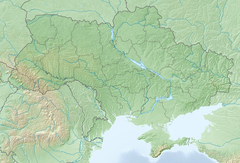
A synagogue, also called a shul or a temple, is a place of worship for Jews and Samaritans. It has a place for prayer where Jews attend religious services or special ceremonies such as weddings, bar and bat mitzvahs, choir performances, and children's plays. They also have rooms for study, social halls, administrative and charitable offices, classrooms for religious and Hebrew studies, and many places to sit and congregate. They often display commemorative, historic, or modern artwork alongside items of Jewish historical significance or history about the synagogue itself.

The Sofia Synagogue is a Romaniote Orthodox Jewish congregation and synagogue, located in Sofia, Bulgaria. Completed in 1909, the synagogue is the largest synagogue in Southeastern Europe, the third-largest in Europe, and one of two active synagogues remaining in Bulgaria.

Velyki Mosty is a city in Chervonohrad Raion of Lviv Oblast (region) of Western Ukraine. It hosts the administration of Velyki Mosty urban hromada, one of the hromadas of Ukraine. Its population is 6,286.
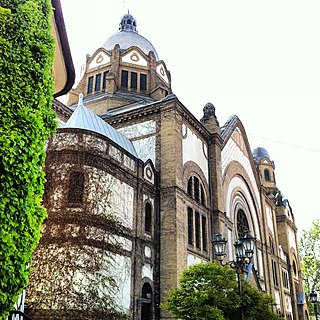
The Novi Sad Synagogue is a former Neolog Jewish congregation and synagogue, located on Jevrejska (Jewish) Street, in the city center of Novi Sad, in the province of Vojvodina, Serbia. Completed in 1909, the building was used as a synagogue until c. 1966; and subsequently used as cultural center since 2012. During its use, with a capacity of 900 worshipers, the synagogue was one of the largest synagogues in Central Europe.

Tempel Synagogue was a Progressive Jewish synagogue, located at the Old Market Square 14 in Lviv, at the time part of the Austro-Hungarian Empire; and, since 1991, now in Ukraine. Lviv was one of the first Galician cities to have a modernized synagogue. The synagogue was destroyed by Nazi Germany in 1941, following Operation Barbarossa.

The Synagogue in Chachmei Lublin Yeshiva is a synagogue located in Lublin, Poland, in the building of Chachmei Lublin Yeshiva, on Lubartowska 85 Street.
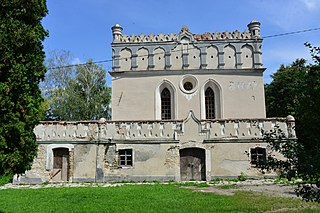
The Great Synagogue (Festungs-Schule) is a former Orthodox Jewish synagogue, located on Geroiv Maydany Street, in Husiatyn, Ternopil Oblast, Ukraine. The congregation worshipped initially in the Ashkenazi rite; however, by the late 19th-century, the congregation worshipped according to Hassidic practices.
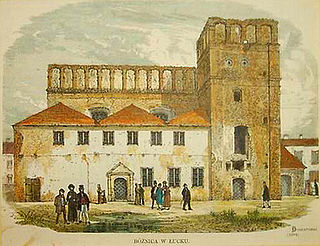
The Great Synagogue is a former Orthodox Jewish synagogue, located at 33 Karaimska Street, in the Jewish quarter of Lutsk, in Volynska Oblast, Ukraine. The congregation worshipped in the Ashkenazi rite.

The Kharkiv Choral Synagogue is an Orthodox Jewish synagogue, located at 12 Pushkinska Street, Kharkiv, in the Kharkiv Oblast of Ukraine. The Chabad congregation worships in the synagogue, also called Beit Menachem, reportedly the largest synagogue in Ukraine, and a building of architectural significance.
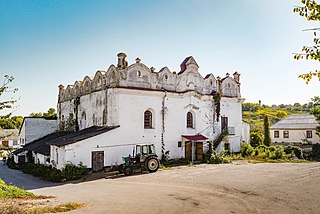
The Great Synagogue is a Jewish synagogue, located in Sharhorod, in the Vinnytsia Oblast of Ukraine. Built in 1589 in what was then the Polish–Lithuanian Commonwealth, it is one of the oldest synagogues in Ukraine.

Pohrebyshche Synagogue was a former Jewish synagogue, located in Pohrebyshche, a town in Vinnytsia Oblast, Ukraine. The wooden synagogue was built in 1690, to replace an earlier synagogue, and was destroyed by German Nazis during World War II.

The Great Synagogue is a Jewish synagogue, located on Synahoha, in Sataniv, a town in the Khmelnytskyi Oblast of Ukraine. Built in 1514 in what was then the Kingdom of Poland, it is one of the oldest synagogues in Ukraine.

The Choral Synagogue, also called the Great Synagogue, is an Orthodox Jewish synagogue, located on Pylypa Orlyka Street, in Drohobych, Lviv Oblast in Ukraine. The congregation worships in the Ashkenazi rite.

The Great Synagogue was a former Jewish synagogue, located in Pidhaitsi, Ternopil Oblast in Ukraine. The congregation worshipped in the Ashkenazi rite. Built prior to 1648, the fortress synagogue was abandoned during World War II, was used for grain storage thereafter, then as a ruin before its collapse in 2019 and subsequent demolition.

The Great Synagogue or Choral Synagogue is a former Orthodox Jewish synagogue, located on Yaroslava Mudroho Street, in Bila Tserkva, in the Kyiv Oblast of Ukraine. The synagogue was built in the former Russian Empire in 1860 and the congregation worshipped in the Ashkenazi rite.
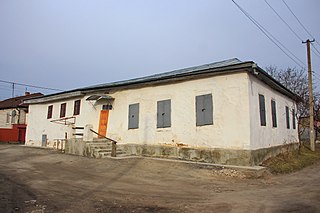
The Bershad Synagogue is an Orthodox Jewish synagogue, located on Narodna Street, in Bershad, in the Vinnytsia Oblast of Ukraine. Built in the beginning of the 19th century, it is one of the very few synagogues in Ukraine that was neither destroyed during World War II nor closed by the Soviet authorities in the years after the war.

Jerzy Czarnecki was a Polish Jewish Holocaust survivor who became a nuclear engineer, expert in nuclear power stations and nuclear pollution control. In Poland, he was employed at WAT as professional officer till 1968; in Switzerland, he worked at the Hauptabteilung für die Sicherheit der Kernanlagen. In the last years of his life, he engaged in reviving the memory of Shoah, in the Ukraine and in Switzerland, and a movie was made on his life and perpetuation activities.

The Great Synagogue of Brody, also known as the Old Fortress Synagogue, is a former Orthodox Jewish synagogue, located in Brody, in the Lviv Oblast of Ukraine. The congregation worshipped in the Ashkenazi rite. Constructed in the mid-18th century in the former Polish–Lithuanian Commonwealth, the building was significantly damaged by the Nazis in 1943, and has since fallen into disrepair.
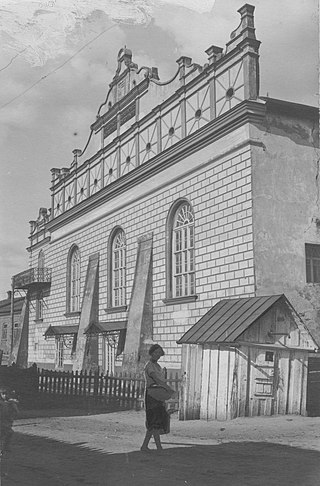
The Great Maharsha Synagogue is a former Jewish synagogue, located in Ostroh, in the Rivne Oblast of Ukraine.

